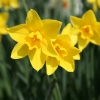Features
This is a division 7 ‘Jonquilla’ daffodil. The flowers, of which there are usually one but occassionally two per stem, have a sunshine yellow perianth (the outer petals) and corona (the inner, trumpet-like petal). They grow to about 6cm wide and are fragrant.
What to use it for
Excellent for spring interest in beds, borders and containers. Can also be used as cut flowers (stand them in cold water alone for at least 3 hours before mixing with other flowers, during which time they will exude a slimy sap which would otherwise harm companion cut flowers).
How to look after it
Plant daffodil bulbs so that the neck of the bulb is planted to a depth of twice the height of the bulb. How far apart you plant the bulbs depends on whether you want a mass of flowers or to increase the production of offsets for propagation – to maximise offset production the bulbs should be planted twice the diameter of a bulb apart from each other. Plant closer for a more dramatic flowering effect.
The bulbs should be planted from early to late autumn; planting earlier in this period will give the roots more time to develop well. The planting can be carried out by creating individual holes or by digging trenches. Each bulb should be placed upright.
The bulbs will grow well in fertile (nutrient-rich) soil, but if you wish to feed them a balanced fertiliser can be added as top dressing when planting, with a more potassium rich fertiliser being used nearer flowering time (using a nitrogen rich fertiliser will encourage foliage growth rather than flowering).
The annual lifting of bulbs is not necessary, but you may wish to do so to check the health of the bulbs, spread them out, make room for other plants, change your display or to propagate new plants. Bulbs should be lifted in summer as the foliage is naturally dying back. Ideally, bulbs should be replanted within 6 weeks of being lifted, but will generally survive for up to 5 months out of the ground. Lifted bulbs should be checked for signs of pests or disease (discard any which are affected), dried in a cool location, then placed into breathable bags (eg net or sacking bags) and well labelled by cultivar name. If the bulbs are particularly precious they can be treated with fungicide before being stored. Keep the bags of bulbs in a cool, dark, dry, well aerated location.
Daffodils can also be moved ‘in the green‘ if it is done when they are flowering or shortly afterwards. Care should be taken to minimise any root, stem or leaf damage when moving and the bulb should be re-planted slightly deeper than it was originally. They may take a couple of years to start flowering again, but should survive the process. However, it’s best to move them as dormant bulbs if possible.
How to prune it
Once flowering is over daffodils can be deadheaded either by cutting off the heads with secateurs or by simply snapping off the heads by hand. Deadheading will stop the plant putting its energy into seed production and it will, instead, put its efforts into regenerating the bulb for good flowering next year. The foliage should be retained until it starts to die back naturally in summer, when it can be pulled out along with the flower stem. Removing the foliage earlier, or even just tying it up to neaten it, will greatly reduce the energy production through photosynthesis, which recharges the bulb for the following year’s growth.
How to propagate it
Daffodils can be propagated after lifting by the division of offsets, scaling/twin-scaling or chipping.
Common problems
Poor flowering, which is also known as ‘blindness‘, may be the result of planting at an incorrect depth, too little sunlight, recent transplantation ‘in the green’, overcrowding, a lack of nutrients, use of a nitrogen rich fertiliser or defoliation before the leaves died down naturally.
Daffodils can be attacked by large narcissus flies, narcissus eelworms, slugs, bulb scale mites, pollen beetles and aphids. Tulip grey bulb rot, white root rot, smoulder, root and foot rots, leaf scorch and viral diseases such as yellow stripe can also be a problem. Bulbs in storage can suffer from blue mould rot.
Other useful information
This daffodil has been given the Award of Garden Merit by the RHS. It was developed in c.1936 by Dr R.V.Favell, who bred daffodils in Cornwall, UK, following his retirement from medicine.
The genus name ‘Narcissus‘ is said to derive from the Greek myth of Narcissus, who fell in love with his own reflection, perishing from staring at it in a pool of water (dying either by drowning or starvation). Legend has it that the first daffodil plant sprang up from the place where he died. Another theory is that the name originates from the Greek for numbness, relating to the toxic effects from consuming the bulb. The common name of daffodil is a perversion of ‘Asphodelus‘, another genus of yellow and white flowers.
The daffodil is the national flower of Wales and is often associated with the celebration of Easter. It is also used as a symbol of various cancer charities around the world.
All parts of daffodils are toxic if consumed, and the bulbs can also be a skin irritant. The similarity of daffodil bulbs and onion bulbs has led to a number of poisoning cases.






